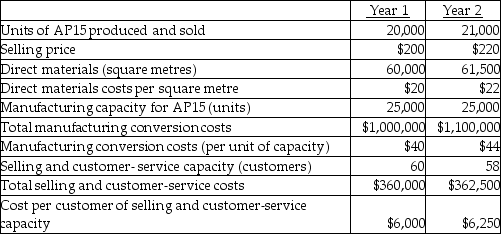Use the information below to answer the following question(s) .Following a strategy of product differentiation, Luke Company makes a high-end Appliance, AP15.Luke Company presents the following data for the years 1 and 2.  Luke Company produces no defective units but it wants to reduce direct materials usage per unit of AP15 in year 2.Manufacturing conversion costs in each year depend on production capacity defined in terms of AP15 units that can be produced.Selling and customer-service costs depend on the number of customers that the customer and service functions are designed to support.Neither conversion costs or customer-service costs are affected by changes in actual volume.Luke Company has 46 customers in year 1 and 50 customers in year 2.The industry market size for high-end appliances increased 5% from year 1 to year 2.
Luke Company produces no defective units but it wants to reduce direct materials usage per unit of AP15 in year 2.Manufacturing conversion costs in each year depend on production capacity defined in terms of AP15 units that can be produced.Selling and customer-service costs depend on the number of customers that the customer and service functions are designed to support.Neither conversion costs or customer-service costs are affected by changes in actual volume.Luke Company has 46 customers in year 1 and 50 customers in year 2.The industry market size for high-end appliances increased 5% from year 1 to year 2.
-What is the Luke Company's cost effect of price-recovery component?
Definitions:
Long Run
In economics, a period in which all factors of production and costs are variable, allowing all inputs to be adjusted.
Average Variable Cost
The total variable costs of production divided by the quantity of output produced, representing the cost per unit of output.
Total Revenue
The complete sum of funds a company acquires from selling goods or offering services over a specified time period.
Operating Profit
The profit earned from a firm's core business operations, excluding deductions of interest and taxes.
Q10: Using the direct method,what amount of Data
Q44: Comics Plus has a current production level
Q60: Partial productivity multiplied by the quantity of
Q77: In linear programming,the goals of management are
Q81: What is the high-low estimate of the
Q103: If the incremental method were used,what amount
Q105: Quantitative factors are always expressed in financial
Q115: The managers of the production department have
Q124: If a dual-rate cost allocation method is
Q164: What are the pencil casings' sales value